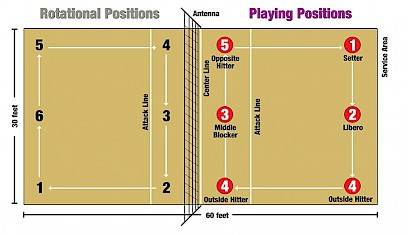Volleyball
A little introduction about Volleyball and how to play it.
INTRODUCTION :
- Volleyball is a team sport played by two teams of six players on a court divided by a net.
- The object of the game is to send the ball over the net in order to ground it on the opponent’s court, and to prevent the same effort by the opponent.
- Volleyball was invented by William G. Morgan, Physical Director of the Young Men’s Christian Association (YMCA) in 1895 in Massachusetts [USA].
- The Federation Internationale de Volleyball [FIVB] is the international governing body for all forms of volleyball.
- Volleyball has been part of the Summer Olympics program for both men and women consistently since 1964.
GENERAL RULES :
- A player on one of the teams begins a 'rally' by serving the ball (tossing or releasing it and then hitting it with a hand or arm), from behind the back boundary line of the court, over the net, and into the receiving team's court.
- The team that wins the rally is awarded a point and serves the ball to start the next rally.
- When serving, the player steps on or across the service line, as while making contact with the ball is a foul.
- Failure to serve the ball over the net successfully is a foul.
- Serving out of rotation/order is a foul.
- It is legal to contact the ball with any part of a player’s body.
- 06 players on the court at any one time - 03 in the front zone/row and 03 in the back zone/row.
- Back-row player attacking a ball inside the front zone/row, at the moment of contact, if the ball is completely above the net is an illegal attack.
- Each team has three hits to attempt to return the ball.
- Player may not hit the ball twice in succession (A block is not considered a hit).
- A ball hitting a boundary line is in.
- Contacting the ball illegally (double touching, lifting, carrying, throwing, etc.) is a foul.
- Touching the net with any part of the body while the ball is in play is a foul.
- A ball is out if it hits an antennae, the floor completely outside the court, any of the net or cables outside the antennae, the referee stand or pole, the ceiling above a non-playable area.
- The libero is a player specialized in defensive skills. The libero must wear a contrasting jersey colour (different dominant colour) from any colour of the rest of the team.He cannot block or attack the ball when it is entirely above net height.
SPECIFICATIONS :
- The Court :
- A volleyball court is rectangular & symmetrical and 9 metres wide by 18 metres long, divided into equal square halves by a net.
- The top of the net is 2.43 metres above the centre of the court for men's competition, and 2.24 metres for women's competition.
- The net is 1 metre wide and 9.50 to 10 metres long, made of 10 cm square black mesh.
- To help game officials judge whether served or volleyed balls are in or out of bounds, a flexible rod made of fibreglass or similar material known as Antenna (1.80 metres long) extends 80 cm above the net along the outer edge of each vertical tape marker. A ball must pass over the net entirely between the antennae.
- The boundary lines form a rectangular shape around the court.
- The end lines/back lines are the short boundary lines on short sides of the court.
- The side-lines are the long boundary lines on the long sides of the court.
- The centre line extends from side-line to side-line underneath the net.
- The attack lines are the lines placed 3 meters from the centre line of the court.
- The 3 meter attack lines divides the court into "back court/zone" and "front court/zone" areas.
- The serving area is the area behind the end line where the server serves.

- The Ball :
- The ball shall be spherical, made of a flexible leather or synthetic leather case with a bladder inside, made of rubber or a similar material.
- Its circumference is 65-67 cm and weight is 260-280 g.
- Toss :
- Each game will start with a toss in the presence of the two team captains.
- The correct guess gives the "winner" the option (a) to serve or receive first. (b) to start play at one end of the court or the other.
- Rotation
- A rally is the sequence of playing actions from the moment of the service hit by the server until the ball is out of play.
- If the serving team wins a rally, it scores a point and continues to serve.
- If the receiving team wins a rally, it scores a point and it must serve next.
- When the receiving team has gained the right to serve, its players rotate one position clock-wise: the player in position 2 rotates to position 1 to serve; the player in position 1 rotates to position 6, etc.
- A rotational fault is committed when the service is not made according to the rotational order. The opponent gains a point and next service

- Scoring System :
- The match is won by the team that wins three sets.
- A set (except the deciding 5th set) is won by the team, which first scores 25 points with a minimum lead of two points.
- In the case of a 2-2 tie, the deciding 5th set is played to 15 points with a minimum lead of 2 points.
FUNDAMENTAL SKILLS
- Underhand Service and Overhand Service

- Passing

- Setting

- Attacking


- Blocking

FAMOUS PLAYERS :
- NATIONAL : Jimmy George [*Arjuna Award-1976], Tom Joseph [*Arjuna Award-2014]
- INTERNATIONAL : Gavin Schmitt (Canada), Earvin Ngapeth (France)
IMPORTANT CUPS AND TROPHIES :
- NATIONAL : Indira Pradhan Trophy, Shivanthi Gold Cup
- INTERNATIONAL : World Cup
*Arjuna Award : The Arjuna Awards are given by the Ministry of Youth Affairs and Sports, Government of India to recognize outstanding achievement in sports.





